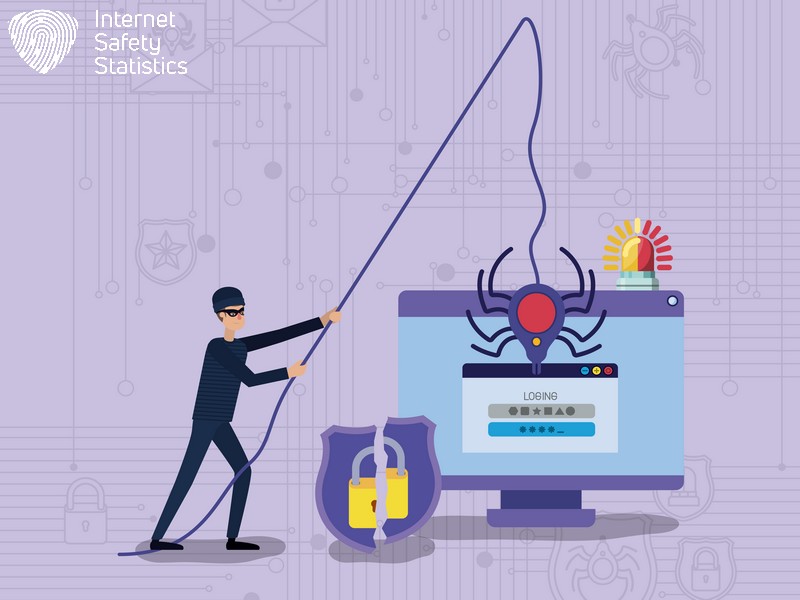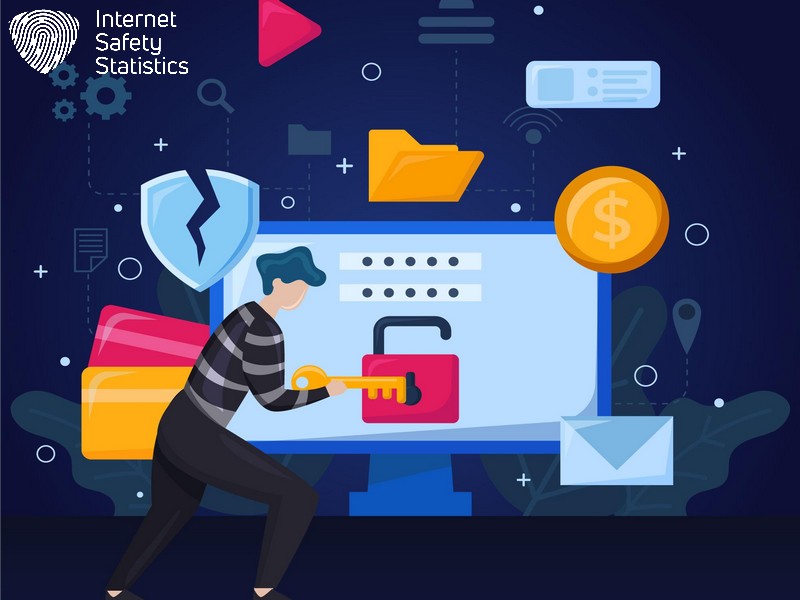
Phishing attacks are a constant threat in today’s digital world, often disguised as legitimate emails or messages. These scams can trick you into revealing sensitive passwords or financial details. Feeling unsure about a suspicious email? This comprehensive guide equips you with the knowledge to detect and prevent phishing attempts. We’ll explore red flags to watch for, explain preventative measures, and empower you to protect yourself from phishing scams.
Stay alert – let’s dive in!
Understanding Phishing Attacks
Phishing involves using deceptive emails, texts or calls to trick individuals into giving out personal or sensitive information. There are different types of phishing attacks, such as spear and smishing, each with tactics to deceive people.
What is Phishing?
Phishing is a sneaky digital con where scammers, posing as trustworthy entities, send out messages to steal sensitive data. They commonly use emails or texts to lure you into providing personal details like passwords or bank information. Imagine getting an email that looks like it’s from your bank asking for urgent verification of your account; this could be phishing.
Scammers craft these manipulative messages to panic you into acting fast without thinking. They play on fear, urgency, or even curiosity. The goal is simple: tricking you into clicking on fraudulent links that install malware or lead you to fake websites where they capture your information. Spotting these deceptive tactics can save you from identity theft and protect your financial security.
Types of Phishing Attacks (Spear Phishing, Vishing, Whaling, Smishing, Clone Phishing)
Having understood phishing, let’s delve into the various attacks. Each type uses different methods to trick individuals into revealing sensitive information or downloading malware. Here are the different types:
- Spear Phishing: Tailored emails that appear to be from someone you know, attempting to gain personal information.
- Vishing: Phishing attacks over the phone, where scammers try to extract personal information by pretending to be legitimate entities.
- Whaling: Targeted at high-profile individuals within an organisation seeking confidential data or access to financial accounts.
- Smishing: Phishing attempts through SMS or text messages containing malicious links or requesting sensitive information.
- Clone Phishing: Emails that appear to be legitimate copies of previously delivered emails with altered content or links leading to fraudulent websites.
How to Detect and Prevent Phishing? Phishing Email Characteristics
Poor grammar and spelling, requests for personal information, urgent or threatening language, and mismatched URLs are all red flags to look out for in a phishing email. Identifying these characteristics is important to avoid falling victim to a phishing attack.
Poor Grammar and Spelling
Sloppy grammar and spelling mistakes are common red flags of phishing emails. Scammers often use poor language skills to create a sense of urgency or legitimacy. Look for emails riddled with grammatical errors or misspelt words, which indicate potential phishing attempts. It’s essential to stay vigilant and scrutinise any email that contains such errors, as they can be an early warning sign of a malicious attack.
Requests for personal information should also raise concerns, especially if coupled with shoddy writing. Suppose you come across suspicious emails with sloppy grammar and requests for personal details. In that case, it’s crucial to report them immediately and refrain from responding or clicking on any links provided within the message.
Requests for Personal Information
Phishing emails often request personal or financial information, such as account numbers, passwords, or social security numbers. These requests may appear from legitimate sources, but it’s important to remember that reputable organisations never ask for sensitive information via email. Be cautious and avoid providing personal details in response to unsolicited emails requesting such information. Always verify the sender’s authenticity before taking any action.
When responding to emails containing requests for personal information, exercise caution and refrain from divulging any sensitive data unless you have verified the source’s legitimacy.
Urgent or Threatening Language
Be cautious of emails or messages that compel you to take immediate action, create fear, or threaten consequences if you don’t act. Scammers often use urgent or threatening language to manipulate your emotions and coerce you into sharing sensitive information. Remember that legitimate organisations wouldn’t pressure you with urgent demands for personal details or financial transactions via email or text.
Recognising phishing attempts is crucial to safeguarding yourself from potential threats. If an email elicits a sense of urgency, makes alarming claims, or uses intimidating language to push for quick responses, it’s likely a red flag for a phishing scam.
Mismatched URLs
Mismatched URLs can be a clear indicator of a phishing attempt. Check the web address in the URL to ensure it matches the legitimate website you expect to visit. Additionally, hover over hyperlinks in emails to reveal the destination before clicking on them, and avoid entering personal information on websites with suspicious or mismatched URLs.
Be cautious when you notice unusual domains, such as misspelt variations of well-known websites, as these could signal an attempt to deceive and steal sensitive information. Always remember that legitimate companies will not ask for important details via insecure channels.
Protecting against phishing attacks involves being vigilant and paying attention to the URL details in unsolicited messages or websites. By staying wary and double-checking web addresses before providing any personal data, you can effectively defend yourself against potential scams aimed at stealing your information.
The Damage of a Successful Phishing Attack

A successful phishing attack can result in the loss of sensitive information, disruption to productivity, and financial losses. Keep reading this comprehensive guide to learn more about detecting and preventing phishing attacks.
Loss of Sensitive Information
Phishing attacks can lead to the loss of sensitive personal and financial information, putting individuals and organisations at risk of identity theft, financial fraud, or data breaches. This can result in significant harm, including financial losses and damage to one’s reputation. Internet users must be aware of this threat and proactively protect themselves against such malicious attempts.
By staying informed about phishing scams and taking steps to secure personal data, individuals can safeguard their sensitive information from falling into the wrong hands. Preventing the loss of sensitive information involves educating oneself about common phishing tactics and being cautious when interacting with emails or messages requesting personal details.
Disruption to Productivity
Following a phishing attack, the disruption to productivity can be significant. Employees may need to spend time dealing with the aftermath of an attack rather than focusing on their usual tasks, leading to a decrease in overall efficiency and output.
This loss of productivity can also extend beyond the initial impact, as employees may become more cautious when handling emails or conducting online activities, consequently spending additional time scrutinising communications and being overly cautious with their actions.
Furthermore, if personal or sensitive company information is compromised during a phishing attack, it could lead to project delays or potential data breaches that further hinder workflow.
Financial Losses
Phishing attacks can lead to significant financial losses for both individuals and businesses. Victims may suffer from unauthorised transactions, stolen funds, or identity theft, resulting in severe monetary repercussions. Moreover, the cost of recovering from a phishing attack can be substantial, including expenses related to legal fees, credit monitoring services, and data breach notification requirements.
Businesses may also face additional financial burdens, such as regulatory fines and loss of customer trust, which can impact their bottom line significantly. Protecting against financial losses due to phishing attacks involves taking proactive measures such as implementing robust cybersecurity protocols and conducting regular security awareness training.
Prevention Measures
Stay vigilant and always be wary of suspicious emails, keep your software updated to prevent vulnerabilities, use strong passwords and multi-factor authentication for added security, and conduct regular security awareness training to educate yourself and your employees. These measures can help to protect against phishing attacks and minimise the risk of falling victim to cyber threats.
Staying vigilant
Remain alert and cautious when browsing emails or texts, as scammers often disguise themselves as legitimate entities to deceive unsuspecting individuals. Recognising potential phishing attempts by carefully inspecting email addresses, checking for suspicious links, and scrutinising unexpected requests for personal information is pivotal in safeguarding against fraudulent activities.
Stay informed about the latest phishing trends and common scam tactics to bolster your ability to identify and evade potential threats. Implement robust security measures such as regularly updating antivirus software, utilising multi-factor authentication, and seeking reputable anti-phishing tools to fortify your defence against malicious attacks.
Keeping Software Updated
Update your software regularly to protect against phishing attacks. Regular updates ensure security patches are in place, reducing vulnerabilities that scammers could exploit. Staying current with software versions adds an extra defence against malicious activities like phishing. Additionally, running the latest version of your software can help safeguard personal and financial information from falling into the wrong hands.
Ensuring your software is updated is a crucial defence against cyber threats like phishing scams. It’s an important step in protecting yourself and your data online.
Using Strong Passwords and Multi-Factor Authentication
Update security on your accounts by using strong, unique passwords and enabling multi-factor authentication. Utilise a combination of uppercase and lowercase letters, numbers, and symbols to create complex passwords difficult for cybercriminals to crack. Additionally, enable multi-factor authentication (MFA) for an extra layer of protection – this requires a verification code sent to your phone or email when logging in from an unrecognised device. This significantly reduces the risk of unauthorised access even if your password is compromised.
Conducting Regular Security Awareness Training
Regular security awareness training is crucial for individuals and organisations to stay informed about the latest phishing threats and prevention tactics. By educating employees or family members, you can empower them to recognise suspicious emails, malicious links, and social engineering attempts.
This proactive approach enhances their ability to identify potential phishing scams and helps create a strong line of defence against cyber-attacks. Organisations should conduct regular workshops on identifying phishing attempts using real-life examples as it creates a better understanding of how scammers operate.
Interactive simulations during these sessions can make the learning process engaging and memorable. Encouraging active participation in identifying red flags in an email or website link helps reinforce the learned lessons effectively. It is equally important for parents to educate their children about online safety practices to minimise the risk of falling victim to phishing attacks.
What to Do if You Suspect or Fall Victim to a Phishing Attack

Contact your IT support immediately, change passwords, monitor accounts for suspicious activity, report the attack to the relevant authorities, and consider implementing anti-phishing tools to prevent future attacks. Read on to learn more about protecting yourself from this common online threat.
Contacting IT Support
If you suspect or have fallen victim to a phishing attack, promptly seek assistance from your organisation’s IT support team. Inform them about the suspicious activity and provide any relevant details.
Additionally, immediately change your passwords and monitor your accounts for unauthorised transactions or activities. It is crucial to report the incident to ensure that appropriate measures can be taken to mitigate the impact of the phishing attack and prevent further compromise of sensitive information.
Implementing anti-phishing tools your IT support recommends can also help enhance protection against future phishing attempts. Moreover, educating yourself and others about recognising phishing attempts through security awareness training will significantly minimise the risk of falling victim to such scams.
Changing Passwords and Monitoring Accounts
To enhance your protection against phishing attacks, changing passwords and monitoring accounts are crucial steps. By updating passwords regularly, you can limit the potential risk of a successful phishing attack. Implementing strong, unique passwords for each account further improves cybersecurity and makes it harder for malicious actors to access multiple platforms in case of a breach. Regularly monitoring your financial, email, and social media accounts is essential for promptly identifying any unauthorised activity that could indicate a phishing attack or other security breach.
Reporting the Attack
After changing passwords and monitoring accounts, it’s crucial to report the phishing attack immediately. Contact your organisation’s IT support team to inform them of the incident and provide any relevant details. This will help identify trends and potential weaknesses in the system that attackers may have exploited. Additionally, implementing anti-phishing tools can aid in preventing future attacks by bolstering your overall security measures. Educating employees about effective reporting procedures is also vital for a swift response to mitigate the impact of phishing attacks.
Implementing Anti-Phishing Tools
Following a suspected or successful phishing attack, one effective measure to safeguard against future incidents is the implementation of anti-phishing tools. These tools can provide an added layer of security by identifying and blocking malicious emails, links, and attachments before they reach your inbox. Furthermore, anti-phishing software can help individuals and businesses protect their sensitive information from falling into the wrong hands.
Implementing anti-phishing tools is imperative in today’s digital landscape, where cyber threats are increasingly sophisticated. By incorporating these measures, you can minimise the risk of falling victim to phishing attacks while maintaining a secure online environment for yourself and your organisation.
Recognising and preventing phishing attacks is crucial in safeguarding personal and financial information. Educating individuals on the characteristics of phishing emails and staying vigilant can help mitigate the risk. Implementing anti-phishing tools and conducting security awareness training is essential to defending against malicious actors. Individuals and organisations can significantly reduce the impact of these fraudulent activities by taking proactive steps to identify and prevent phishing scams.
FAQs
1. What are phishing attacks, and how can I spot them?
Phishing attacks are scams where fraudsters trick you into giving out personal information through fake emails or websites. You can identify these by checking for odd email addresses, spelling mistakes, and suspicious links.
2. Can educating employees help prevent phishing in the workplace?
Yes, teaching your staff about identifying phishing scams is a key defence. Make sure they know how to recognise fraudulent emails and websites to avoid falling victim to online fraud prevention.
3. What should I do if I encounter a potential phishing email?
If you suspect an email is part of a phishing scam, don’t click any links or download attachments. Report it, delete it immediately, and inform your IT department or use antiphishing measures if available.
4. Are there tools that protect against email phishing effectively?
For sure! Use internet security software with antiphishing features that alert you about potentially harmful sites and emails, thus helping mitigate phishing threats.
5. How important is creating awareness around avoiding phishing and spoofing among internet users?
Creating high levels of awareness of the latest tactics used by malicious actors is crucial for defending against Phishing Attacks, as informed users are much less likely to fall prey to these schemes.
